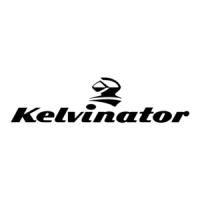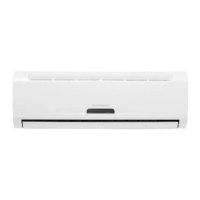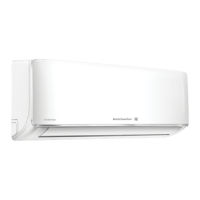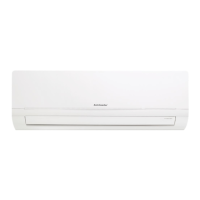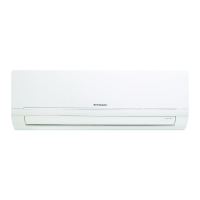Do you have a question about the Kelvinator KSE62HRA and is the answer not in the manual?
Key warnings related to safe installation, electrical work, and component usage.
Specifies the recommended operating temperature ranges for cooling and heating modes.
Lists essential tools and items required for the installation process.
Details pipe diameter requirements for different model capacities.
Specifies clearance requirements around the indoor unit and important installation notes.
Provides critical cautions for optimal performance, including height, pipe length, and obstructions.
Guidelines for positioning the indoor unit, including clearances and pipe run requirements.
Guidelines for positioning the outdoor unit, considering clearances and environmental impact.
Specific requirements and considerations for installing the outdoor unit on a rooftop.
Specifies maximum piping length, elevation differences, and additional refrigerant needs.
Details on how to fit the installation plate to the wall according to structural requirements.
Procedure for determining hole positions and drilling the wall for pipe passage.
Steps for cutting refrigerant pipes and removing burrs for proper flaring.
Instructions on fitting flare nuts and using the flaring tool for pipe connections.
Method to check the quality of flared pipe sections for defects.
Procedure for routing tubing, drain hose, and connecting electrical cables.
Bundling pipes, mounting the indoor unit, and connecting piping.
Steps for wrapping insulation material around piping connections and bundling them.
Specific instructions for routing tubing, drain hose, and cable for rear left piping.
Instructions for inserting piping, drain hose, and connecting cable into the wall opening.
Procedure for installing the indoor unit onto the wall plate, including spacers.
Connecting piping to the indoor unit and wrapping insulation material around connections.
Procedure for aligning and hand-tightening flare nuts on outdoor unit piping.
Final tightening of flare nuts using a torque wrench according to specifications.
Electrical safety requirements, circuit breaker specifications, and important cautions for wiring.
Instructions for connecting the power cable to the indoor unit control box terminals.
Wiring diagrams illustrating connections for various indoor and outdoor unit models.
Procedure for connecting the power cable to the outdoor unit control board.
Steps to secure the cable with a cord clamp and refix the control cover.
Guidance on using recognized circuit breakers and isolation devices for power connection.
Detailed cautions for wiring preparation, including circuit specifics, screw tightness, and voltage.
Procedure to check indoor unit drainage by pouring water and verifying flow.
Guidelines for drain piping orientation and common errors to avoid for proper drainage.
Steps for forming piping by wrapping insulation material and securing it with tape.
Preparation steps for air purging, including checking connections and removing valve caps.
Procedure for performing a nitrogen gas leak test on all pipe joints and connections.
Method for checking pipe connections for leaks using soap water and identifying bubbles.
Steps for connecting the vacuum pump and evacuating the system's tubing and unit.
Final steps including opening service valves, releasing pressure, and replacing valve caps.
Instructions for anchoring the outdoor unit securely on a mount or wall.
Steps for preparing the remote control by inserting batteries for test run.
Procedure for operating the unit in test mode using the switch on the indoor unit.
Criteria for evaluating performance, including checking pressures and air temperature differences.
Procedure for collecting all refrigerant into the outdoor unit when servicing or relocating.
Key warnings related to safe installation, electrical work, and component usage.
Specifies the recommended operating temperature ranges for cooling and heating modes.
Lists essential tools and items required for the installation process.
Details pipe diameter requirements for different model capacities.
Specifies clearance requirements around the indoor unit and important installation notes.
Provides critical cautions for optimal performance, including height, pipe length, and obstructions.
Guidelines for positioning the indoor unit, including clearances and pipe run requirements.
Guidelines for positioning the outdoor unit, considering clearances and environmental impact.
Specific requirements and considerations for installing the outdoor unit on a rooftop.
Specifies maximum piping length, elevation differences, and additional refrigerant needs.
Details on how to fit the installation plate to the wall according to structural requirements.
Procedure for determining hole positions and drilling the wall for pipe passage.
Steps for cutting refrigerant pipes and removing burrs for proper flaring.
Instructions on fitting flare nuts and using the flaring tool for pipe connections.
Method to check the quality of flared pipe sections for defects.
Procedure for routing tubing, drain hose, and connecting electrical cables.
Bundling pipes, mounting the indoor unit, and connecting piping.
Steps for wrapping insulation material around piping connections and bundling them.
Specific instructions for routing tubing, drain hose, and cable for rear left piping.
Instructions for inserting piping, drain hose, and connecting cable into the wall opening.
Procedure for installing the indoor unit onto the wall plate, including spacers.
Connecting piping to the indoor unit and wrapping insulation material around connections.
Procedure for aligning and hand-tightening flare nuts on outdoor unit piping.
Final tightening of flare nuts using a torque wrench according to specifications.
Electrical safety requirements, circuit breaker specifications, and important cautions for wiring.
Instructions for connecting the power cable to the indoor unit control box terminals.
Wiring diagrams illustrating connections for various indoor and outdoor unit models.
Procedure for connecting the power cable to the outdoor unit control board.
Steps to secure the cable with a cord clamp and refix the control cover.
Guidance on using recognized circuit breakers and isolation devices for power connection.
Detailed cautions for wiring preparation, including circuit specifics, screw tightness, and voltage.
Procedure to check indoor unit drainage by pouring water and verifying flow.
Guidelines for drain piping orientation and common errors to avoid for proper drainage.
Steps for forming piping by wrapping insulation material and securing it with tape.
Preparation steps for air purging, including checking connections and removing valve caps.
Procedure for performing a nitrogen gas leak test on all pipe joints and connections.
Method for checking pipe connections for leaks using soap water and identifying bubbles.
Steps for connecting the vacuum pump and evacuating the system's tubing and unit.
Final steps including opening service valves, releasing pressure, and replacing valve caps.
Instructions for anchoring the outdoor unit securely on a mount or wall.
Steps for preparing the remote control by inserting batteries for test run.
Procedure for operating the unit in test mode using the switch on the indoor unit.
Criteria for evaluating performance, including checking pressures and air temperature differences.
Procedure for collecting all refrigerant into the outdoor unit when servicing or relocating.
| Brand | Kelvinator |
|---|---|
| Model | KSE62HRA |
| Category | Air Conditioner |
| Language | English |
